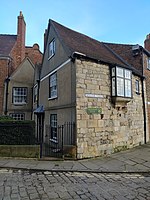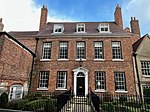The Minster School, York
2020 disestablishments in England7th-century establishments in EnglandBuildings and structures completed in 627Choir schools in EnglandCommons category link is locally defined ... and 8 more
Defunct Church of England schoolsDefunct schools in YorkEducational institutions disestablished in 2020Educational institutions established in the 7th centuryGrade II listed buildings in YorkMinster YardUse British English from October 2017York Minster

The Minster School was an independent preparatory school for children aged 3–13 in York, England. It was founded to educate choristers at York Minster and continued to do so, although no longer exclusively, until in June 2020 it was announced that the school would close at the end of that term.The building is Grade II listed.
Excerpt from the Wikipedia article The Minster School, York (License: CC BY-SA 3.0, Authors, Images).The Minster School, York
Deangate, York Bishophill
Geographical coordinates (GPS) Address Nearby Places Show on map
Geographical coordinates (GPS)
| Latitude | Longitude |
|---|---|
| N 53.961716 ° | E -1.080791 ° |
Address
Deangate
Deangate
YO1 7JB York, Bishophill
England, United Kingdom
Open on Google Maps










